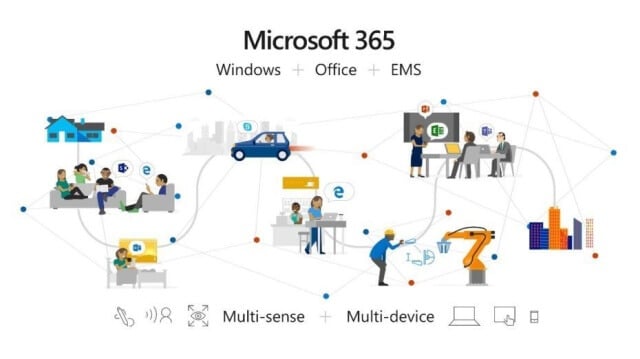The events of 2020 have clearly demonstrated the need not just for virtual communication tools, but for full-package digital workplace solutions that allow employees to work from anywhere at any time without sacrificing collaboration or productivity. This is precisely the value proposition that Microsoft 365 offers.
Sure, Microsoft Teams is a valuable tool and a foundational component of Microsoft’s business suite. But Teams is just the beginning when it comes to the productivity tools at your disposal with a Microsoft 365 membership.
Why companies are making a move to Microsoft Teams
Microsoft Teams wasn’t the only workplace communication app that experienced a steep incline in users in early 2020. Competitors like Zoom and Slack also saw numbers skyrocket thanks to soaring demand for work-from-home solutions. However, Microsoft Teams produced the largest overall increase in new users during this time. According to reports, Teams grew by 894% between February and June of 2020, beating out Zoom at 677%, Webex at 451%, and Slack at 395%.
So what is it about Microsoft Teams that helped fuel its rise to the top? Some experts point to the security issues that plagued Zoom as the company struggled to keep up with such rapid growth. Others cite accusations that Slack misrepresented the features included in its free version, which caps the number of users in an organization and limits video calls to 1-to-1 only. Ultimately, the core advantage of Microsoft Teams is that it integrates seamlessly with Microsoft 365, creating a digital environment in which employees can access all the tools they need in one place.
What is Microsoft 365?
Microsoft 365 is a subscription-based productivity suite that includes dozens of tools and apps. In April 2020, Microsoft rebranded its Office 365 suite to live under the Microsoft 365 name, along with an expanded service bundle. The most popular apps that come with a Microsoft 365 subscription are:
- Word
- Excel
- PowerPoint
- Outlook
- OneNote
- Teams
- SharePoint
- Exchange
- OneDrive
- Skype
- Yammer
- And more
All Microsoft 365 tools are accessed and managed through a central portal, and apps can be used in conjunction with each other, leading to more efficient workflows. For example, files stored in SharePoint can be shared directly in Teams chats, and Teams meetings can be scheduled in Outlook to instantly create calendar events and share them with the right people.
This level of integration cultivates a digital employee experience that Slack or Zoom can’t match. For many companies, this is the major draw to Teams. Through Microsoft 365, participants essentially get an all-in-one solution that addresses not just the need for virtual communication, but the many demands of operating with a remote workforce.
What is the difference between Microsoft Teams and Microsoft 365?
Clearly, the major difference between Microsoft Teams and Microsoft 365 is that the latter is a full suite of digital workplace tools, including Teams, while the former is a solitary app used solely for the purpose of remote communication.
But there are other differences to keep in mind, too. Microsoft offers a free version of Teams that gives access to most of the app’s core features without a monthly subscription fee. There’s no equivalent version of Microsoft 365. To access apps like Word and Excel and take advantage of the integration with Teams, you’ll have to pay a monthly per-user fee. The good news is that subscriptions include the full range of Teams features that don’t come with the free version.

10 Microsoft 365 features to know about
Microsoft Teams is just one of many workplace tools included in an Office 365 subscription. Here are the top ten you should know about:
1. Document editing
We all know Word, Excel, and PowerPoint, the core document editing software that once made up the heart and soul of Microsoft Office. These three apps allow you to create and edit text documents, spreadsheets, and presentations, respectively. While you once had to pay a large upfront fee to purchase each new version, the desktop versions are now only available through a Microsoft 365 subscription that includes licensing and regular updates.
2. Email
Outlook is the Microsoft 365 email client that can be accessed online, through a desktop app, or from mobile devices. Most business subscriptions include email hosting up to 50 GB and email addresses with a custom domain.
3. Calendar
Calendar features are also provided through Outlook, which can once again be viewed and managed on any device. Businesses benefit from features like team calendars, meeting invitations, and sharing of available meeting times based on everyone’s individual schedule.
4. File storage and sharing
Remote teams rely on cloud-based solutions to store and manage documents. This is made possible through SharePoint, a highly versatile platform that organizes a company’s information into sites and subsites that can be accessed through a common intranet. Many companies choose to use a digital workplace enhancement such as Powell Intranet for a more comprehensive SharePoint experience with code-free customization and easier management.
5. Collaboration
The opportunities for collaboration within Microsoft 365 are nearly endless. Microsoft Teams creates a platform for users to chat, hold virtual face-to-face meetings, and share documents. Thanks to SharePoint, companies with a Microsoft 365 subscription can also have multiple users actively working on the same document at the same time from one centrally stored file.
6. Support
No matter which Microsoft 365 subscription your company chooses, you’ll have access to 24/7 online and phone support for issues that may arise at any time of the day, no matter where you are in the world.
7. Mobile device management
Employees using personal and company-provided mobile devices for work presents certain challenges and risks. With some Microsoft 365 subscriptions, administrators can set their own security policies for these devices, including automatic updates and remote wipe abilities in case of loss or theft.
8. Security measures
Microsoft 365 boasts more than a thousand security and privacy controls for its business customers. These include permissions to control who can access content and regular updates to protect against the most recent malware and cyberattacks.
9. Administrative control
All the Microsoft 365 features we’ve mentioned are controlled through the admin centre, which is a dashboard that those with administrative privileges can only access. This is the control hub through which users are added, groups are created, and security and governance policies are managed. Certain apps like SharePoint have their own admin centres with additional settings.
10. Governance
A company’s governance policy dictates how digital tools are used and who has permission to use them, among other points. While the native governance abilities included with Microsoft 365 are limited, they do exist. For example, administrators can set password policies that are applied to all users within the organization. It’s easy to use a third-party tool like Powell 365 for even better control over governance policies.
The features available to businesses through Microsoft 365 provide all the necessary tools to help businesses navigate the new world of remote work. But when combined with Powell Intranet, these platforms form an unstoppable combination. The Powell Intranet-in-a-box solution is designed to enhance the Microsoft 365 experience with faster deployment, more features, and easy management that anyone can oversee without the need for specialized IT training. Schedule a demo to speak with a digital workplace expert about how your organization can leverage the full power of Microsoft 365 and Teams.

